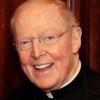
Christmas
About “early holiday decorations and shopping,” it seems, little more can helpfully be said. But what can be said about the “Christmas story” will always be inexhaustible. Even, for example, about demigods and demagogues before whom, unaccountably, human beings have so long been inclined to bow their knees.
In the ancient Near East, kings represented the gods -- and were reverenced accordingly. Israel’s monotheism provided a sharp critique not only of polytheism but of all ruler-worship. But after Julius Caesar, deification of the Roman emperor became common (probably of course taken most seriously among the less educated classes). Augustus was certainly regarded as a god, and on the denarius that Peter found in the fish and showed to Jesus there would have been the inscription “Son of the Divine Augustus.” In the Greek-speaking but multiethnic East, ruler worship was even more common.
Nor was the practice simply ancient. Think of the way Nazi crowds idolized Hitler (and how neo-Nazi terrorists are active today).
The tomb of Mussolini continues to attract devoted followers annually. Mao Zedong’s word was as sacred as any biblical text. Hannah Arendt in The Origins of Totalitarianism (1951) and Czeslaw Milosz in The Captive Mind (1953) provided chilling analyses of totalitarianism and its seductions. Whatever social conditions may have enabled the rise of such figures, there were clearly many who were all too willing to bow before them.
Is this apparently deep-seated human trait, this need to identify with figures more powerful than ourselves, a projection of the divine onto the demagogic leader? (Ludwig Feuerbach argued in the mid-19th century that theology is really simply a projection of anthropology onto an illusory divinity.) Or is such submission rather a perversion of something essentially human and good, indeed salvific? The Christian Gospel, and the Christmas story within it, is here again revelatory -- and politically significant.
In the infancy narratives of Matthew and Luke we have two complementary interpretations of the birth of Jesus that Christian piety has often conflated, imagining Matthew’s Magi and Luke’s shepherds together at the crib. But with their complementary intentions, Matthew seeking to show that Jesus is the Davidic Messiah and Luke wishing to show that Jesus is the Son of God, the two Gospel authors likewise shed special light on the first figures who come to worship the newborn child. It is a child destined to save us all through his sacrificial love before whom they bow, and their particular roles in the story should not be confused.
 Luke’s shepherds, to whom “an angel of the Lord” proclaims the birth “in the city of David [of] a Savior who is Messiah and Lord” and before whom “a multitude of the heavenly host praising God” then also appears, did not capture the Christian imagination as the Magi did. (The shepherds first appear in the Roman catacombs in the fourth century, while the “wise men” had already been depicted as early as the second century.) The shepherds did become more prominent during the Protestant Reformation, especially in Christmas carols, and have recently seemed to supplant the Magi, being “the poor and simple” to whom the revelation of God’s Son was first made. But their symbolism is less that of “simple folk” (shepherds at the time were often considered dishonest) and more a matter of being from the neighborhood of Bethlehem, the city of David the shepherd.
Luke’s shepherds, to whom “an angel of the Lord” proclaims the birth “in the city of David [of] a Savior who is Messiah and Lord” and before whom “a multitude of the heavenly host praising God” then also appears, did not capture the Christian imagination as the Magi did. (The shepherds first appear in the Roman catacombs in the fourth century, while the “wise men” had already been depicted as early as the second century.) The shepherds did become more prominent during the Protestant Reformation, especially in Christmas carols, and have recently seemed to supplant the Magi, being “the poor and simple” to whom the revelation of God’s Son was first made. But their symbolism is less that of “simple folk” (shepherds at the time were often considered dishonest) and more a matter of being from the neighborhood of Bethlehem, the city of David the shepherd.
In Giorgione’s sublimely tranquil “Adoration of the Shepherds” of 1505-1510, warm Italian light suffuses the scene as the landscape opens up on the left toward Bethlehem. Before a cave, two shepherds, one standing and one kneeling, bow over the child Jesus with the elderly Joseph and the serenely beautiful Virgin on the other side of him. The mood, peacefully still for all its ravishing detail, is more contemplative than narrative, a lyrical vision of what true worship means.
 Some 30 years earlier, a Flemish artist, Hugo van der Goes, had portrayed the scene on a grander scale, bathed in northern light and with an extensive cast of characters, each perfectly placed. This version, a triptych known as the Portinari Altarpiece (after its donor), has side panels of the donors and their patron saints and a central panel with the baby lying surprisingly on the bare earth. It teems with symbolic detail -- but is careful to present its three shepherds as realistically rustic, very plain fellows indeed. That would be a constant in the countless interpretations that followed.
Some 30 years earlier, a Flemish artist, Hugo van der Goes, had portrayed the scene on a grander scale, bathed in northern light and with an extensive cast of characters, each perfectly placed. This version, a triptych known as the Portinari Altarpiece (after its donor), has side panels of the donors and their patron saints and a central panel with the baby lying surprisingly on the bare earth. It teems with symbolic detail -- but is careful to present its three shepherds as realistically rustic, very plain fellows indeed. That would be a constant in the countless interpretations that followed.
Matthew’s Magi, on the other hand, underwent considerable change, becoming first kings, then three in number (most often), and acquiring various names -- in the East by the fourth century and in the West by the sixth century, where the names Melchior, Gaspar and Balthasar became common. Symbolism also developed relating the gifts of gold, frankincense and myrrh to Jesus (as king, God, suffering savior) and to the Christian life (virtue, prayer, suffering). An early eighth-century text spoke of Balthasar as “black-skinned,” and thus he began to appear in art of the late 15th century. Perhaps most striking was the appearance of relics of the Magi, the most famous of which have been enshrined in the cathedral of Cologne, Germany, since arriving there in 1162.
 If pious enthusiasm abounded in imagining the Magi-kings, the earliest Western art was blessedly restrained. Duccio’s touching predella piece from his “Maestà” (1308-1315) in Siena, Italy, shows only three kings with groomsmen and two horses, the eldest king kneeling to kiss the foot of the Christ Child on Mary’s lap. A century and a half later, Rogier van der Weyden’s magnificent St. Columba Altarpiece (a triptych) represents the effulgence of mid-15th-century imagination. Here the side panels present the (properly Lucan) themes of the Annunciation (on the left) and the Presentation in the Temple (on the right, with a Romanesque portico serving as the Temple). In the central panel, a stable framed in a Netherlandish landscape is commodious enough to welcome Matthew’s three Magi, in kingly trappings but without crowns, as they pay court to the Christ Child. A donor kneels near St. Joseph at the left, the by-now traditional ox and ass are behind the Virgin and child, and a small crowd of onlookers peers through an arch at the right. This is the fully realized, and significantly aestheticized, adoration scene as it would appear through the Renaissance, Mannerism and the Baroque. It portrays well the Matthaean intention of seekers from distant lands (among the gentiles) who are led, first by nature (the star) and then by scripture (the intelligence they receive in Jerusalem), to the presence of the Messiah. But it risks so decorating and historicizing the scene as to lose its mystery.
If pious enthusiasm abounded in imagining the Magi-kings, the earliest Western art was blessedly restrained. Duccio’s touching predella piece from his “Maestà” (1308-1315) in Siena, Italy, shows only three kings with groomsmen and two horses, the eldest king kneeling to kiss the foot of the Christ Child on Mary’s lap. A century and a half later, Rogier van der Weyden’s magnificent St. Columba Altarpiece (a triptych) represents the effulgence of mid-15th-century imagination. Here the side panels present the (properly Lucan) themes of the Annunciation (on the left) and the Presentation in the Temple (on the right, with a Romanesque portico serving as the Temple). In the central panel, a stable framed in a Netherlandish landscape is commodious enough to welcome Matthew’s three Magi, in kingly trappings but without crowns, as they pay court to the Christ Child. A donor kneels near St. Joseph at the left, the by-now traditional ox and ass are behind the Virgin and child, and a small crowd of onlookers peers through an arch at the right. This is the fully realized, and significantly aestheticized, adoration scene as it would appear through the Renaissance, Mannerism and the Baroque. It portrays well the Matthaean intention of seekers from distant lands (among the gentiles) who are led, first by nature (the star) and then by scripture (the intelligence they receive in Jerusalem), to the presence of the Messiah. But it risks so decorating and historicizing the scene as to lose its mystery.
A great exception to that tendency came from the hand of Diego Velázquez in 1619, very early in his career. This “Adoration of the Magi,” most likely commissioned by the Jesuits in Seville, Spain, for their Novitiate of San Luis, shows a serene Mary with downcast eyes (the painter’s wife was probably the model) holding a doll-like Christ Child. A young Joseph stands to her left, while the Magi, accompanied by a servant, present their gifts. (Here the youngest kneels before the child, and one of the three is black.) The painting has been criticized for some anatomical awkwardness, crowding of the figures, and an unresolved background. But the sober realism and dignity of the figures, the lack of imaginary costuming (no crowns), and the innocent intelligence of the child are spellbinding. Here Velázquez, even though not yet with his fully developed style, typically says the most with the least. This is painting that reveals the opened, liberated hearts of adoration -- and implicitly criticizes all subservience to merely temporal and political power.
This may be one of the prime criteria for art representing the shepherds and the Magi of the infancy narratives. Another is the inclusion in some way of a sense that the birth of Jesus is at the beginning of a story of sacrifice. (The Portinari Altarpiece includes a still life that refers to the Eucharist and the Passion; in the lower right corner of the Velázquez “Adoration” there is a subtle reference to the crown of thorns.) And it is of particular importance that the work plausibly represent a scene of worship. The figures adoring the newborn child should appear together not as actors on a stage but as communally transformed. As a congregation hopes to be, on Christmas morning or on Epiphany, when it gathers to celebrate the eucharistic memory and presence of its Lord, all-powerful in his powerlessness.
Is the instinct for worship a deep-seated human trait or a projection of our need to identify with those more powerful than ourselves? The persistent emergence of dictators and demagogues may indicate the latter. But aspects of the Christmas story richly suggest otherwise.
[Jesuit Fr. Leo O’Donovan is president emeritus of Georgetown University in Washington and a frequent commentator on the arts for NCR.]
Stories in this series
|




